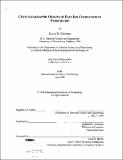| dc.contributor.advisor | Bernhardt J. Wuensch. | en_US |
| dc.contributor.author | Eberman, Kevin W. (Kevin Wilmot), 1971- | en_US |
| dc.date.accessioned | 2010-01-07T20:41:31Z | |
| dc.date.available | 2010-01-07T20:41:31Z | |
| dc.date.copyright | 1998 | en_US |
| dc.date.issued | 1998 | en_US |
| dc.identifier.uri | http://hdl.handle.net/1721.1/50456 | |
| dc.description | Thesis (Ph.D.)--Massachusetts Institute of Technology, Dept. of Materials Science and Engineering, 1998. | en_US |
| dc.description | Includes bibliographical references (p. 129-132). | en_US |
| dc.description.abstract | We have examined the crystallographic origins of fast-ion conduction in oxides with the pyrochlore structure-type, ideally A2B2O7, a superstructure of (A,B)20 3.5 defect fluorite-like array. These materials have technological promise for use in electrochemical devices such as oxygen sensors and solid-oxide fuel-cells. The pathway for ion conduction proposed by several authors has been a jump between equivalent nearest-neighbor oxygen sites through the tetrahedral edges of the relatively-immobile cation array. Substitution of a third cation species in slid-solution in the B site, A2(B-yB'y)2O7, results in a marked change in the structure and properties of the materials which is not fully understood. As the average radius of the cations occupying the B-site increases (with changing composition) towards that of the larger average radius of the cations occupying the Asite, a tendency for increasing disorder has been observed, where complete disorder corresponds to the fluorite structure. A decrease in Frenkel-defect formation-energy and an increase in the migration enthalpy accompanies the disordering. We have executed several studies of pyrochlore structures employing neutron and x-ray powder diffraction. In particular, we have focused on high-temperature in-situ experiments that should better correspond to the structure for which the conductivity measurements were made at elevated temperature ... | en_US |
| dc.description.statementofresponsibility | by Kevin W. Eberman. | en_US |
| dc.format.extent | 132 p. | en_US |
| dc.language.iso | eng | en_US |
| dc.publisher | Massachusetts Institute of Technology | en_US |
| dc.rights | M.I.T. theses are protected by
copyright. They may be viewed from this source for any purpose, but
reproduction or distribution in any format is prohibited without written
permission. See provided URL for inquiries about permission. | en_US |
| dc.rights.uri | http://dspace.mit.edu/handle/1721.1/7582 | en_US |
| dc.subject | Materials Science and Engineering | en_US |
| dc.title | Crystallographic origins of fast-ion conduction in pyrochlore | en_US |
| dc.type | Thesis | en_US |
| dc.description.degree | Ph.D. | en_US |
| dc.contributor.department | Massachusetts Institute of Technology. Department of Materials Science and Engineering | en_US |
| dc.identifier.oclc | 42077776 | en_US |
